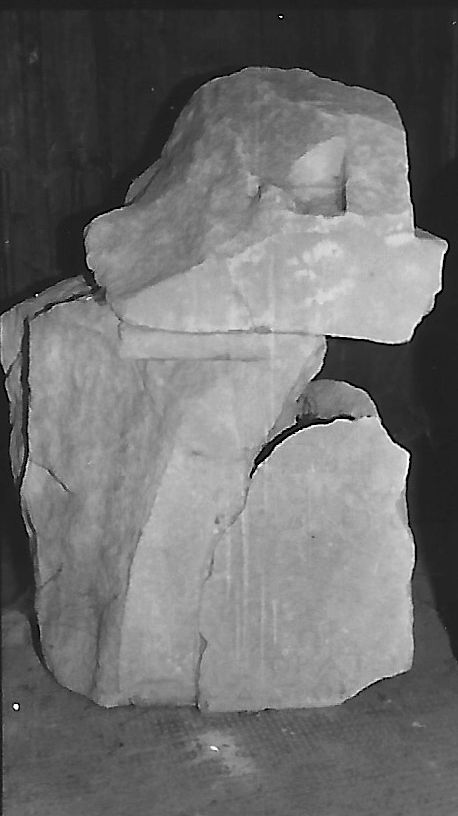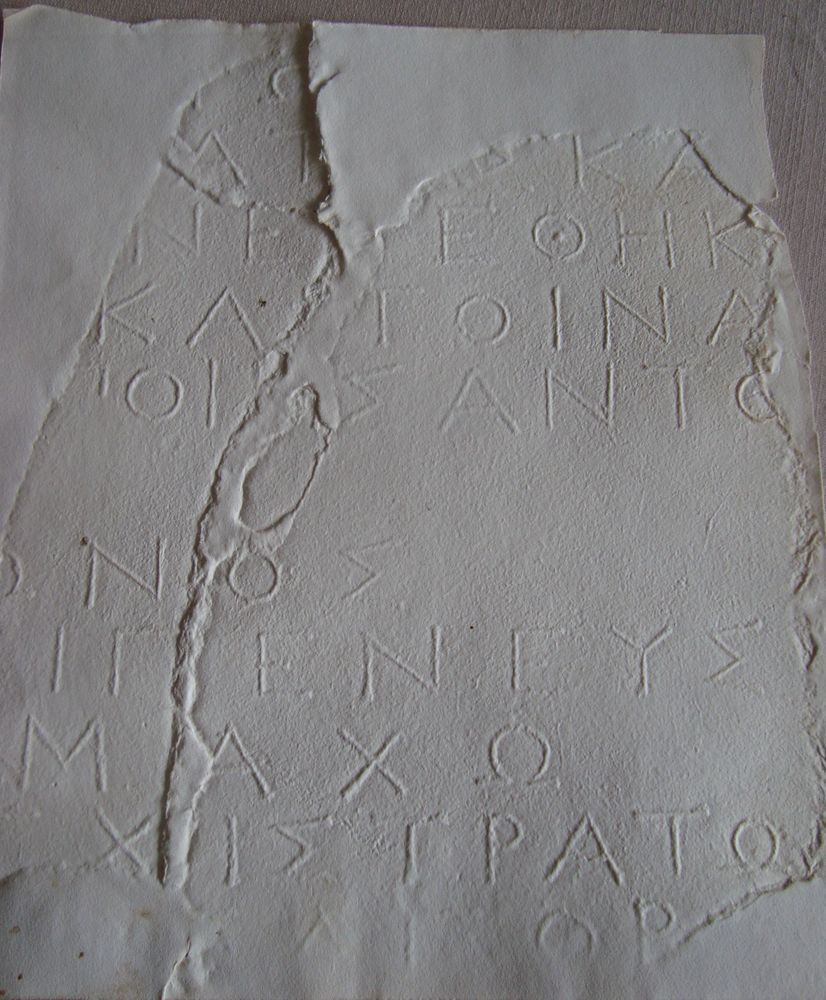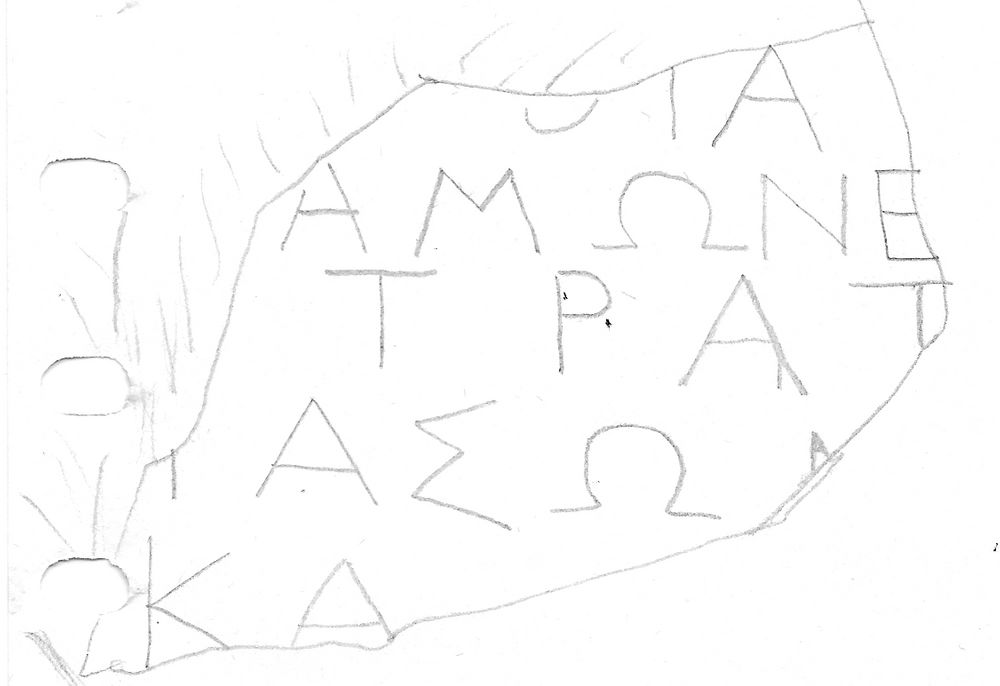EpiDoc XML:
IGCyr0621002
Trismegistos ID:
6067
Source description
Support: At least seven fragments of a white marble stele with the lower front side protruding m. 0.05 ahead of the upper side, which has the form of an aediculum; moulded cornices on top and below of the inscribed face; in the aediculum, a relief of which survives only the lower part of two figures, one seated, the other standing; all fragments had been provisionally pasted together before being photographed for editio princeps; later on, some of the fragments were detached, one of which was registered again with a different inventory number; amongst the four inscribed fragments, three, being adjacent, are here named together a (inv. number 19), which keeps the right original edge, but has lost four lines below since 1951 (as measured in 1976 w: 0.25 × h: 0.30 × d: 0.28); another loose fragment (inv. number 355), here named b, belonged to the left lower part (w: 0.18 × h: 0.11 × d: 0.15); dimensions of the whole monument as measured for publication w: 0.42 × h: 0.82 × d: 0.32.
Layout: Inscribed on the lower part of the face (preserved height 0.36).
Letters: 0.02 at ll. 1-5; 0.017 at ll. 7-11.
Date: Probably third quarter of fourth century BC (lettering).
Findspot: Found between 1939 and 1942 by G. Pesce in excavations at Cyrene ➚: Temple of Zeus.
Place of origin: Findspot.
Last recorded location: Cyrene Museum, 19+355. Both fragments seen by C. Dobias-Lalou in 1979 in Shahat: Cyrene Museum.
Text constituted from: Transcription from stone (CDL).
Bibliography
Pesce 1951, pp. 84-86, n. 1, fig. 1, whence SEG, 17.796; Robert, BE, 1953.251; Morelli, SECir, 244 (only fragment b, as unpublished); IGCyr 062100 ➚; Rosamilia 2023, pp. 377-378, number 104 (text). Cf. Marengo 1985, whence SEG, 36.1461.
Text
Apparatus
1: [Ζηνὶ Λυκα?]ί̣ω[ι] IGCyr, Rosamilia 2023: [---]ΥΩ[---] SECir; [Διὶ Ὀλυμπί]ωι Pesce 1951
2-3: [κ]ατ[έ?]σκα|[ψαν? c. 4]Ν Pesce 1951, IGCyr: ΑΤ[.]ΣΚΑ | [c. 7]Ν SECir, Rosamilia 2023
3-4: ἐπ̣έθηκ|αν Pesce 1951 more consistent with the stone; ἐν̣έθηκ|αν Pesce 1951; Ε [ἀν]έθηκ|αν SECir
4-5: να|[ποῖαι?] Rosamilia 2023: τοὶ να|[κόροι?] Robert, BE, IGCyr; ΤΟΙΝΑ | [---] Pesce 1951
5: [ἐ]ποίησαν τὸ Rosamilia 2023: [ἐ]ποιήσαντο Pesce 1951, SECir, IGCyr
6: [.. ? ..](vac.) Rosamilia 2023: (vac. 1 line) Pesce 1951, SECir, IGCyr
7: [᾿Επὶ] Θ̣ρ̣ά[σ]ωνος: [᾿Επὶ ...]ΟΙΑ[.]ωνος Pesce 1951; [...]ΟΙΑ[.]ωνος SEG
9: <τῶ?>[Σ]τρατ[ο]μάχω Rosamilia 2023: [᾿Επὶ ---]τρατ[ο]μάχω Pesce 1951, IGCyr; [Σ]τρατομάχω SEG
11: Κάλ̣[λιππος?] Λ̣αγόρα: Κάλ̣[λις Καρ?]τ̣αγόρα Rosamilia 2023; Κάλ[λις Ἀρ]ισταγόρα IGCyr; [---]τ̣αγόρα SECir; Κάλ[λις Ἀρ]ισταγόρα () Pesce 1951 ΙΣ do not exist on the photograph
French translation
[A Zeus Lykaios les? ---] ont fait creuser et ont placé au-dessus [---] et les [néopes?] ont mis à exécution le [.. ? ..]. (vac. 1 line) [Sous] Thrasôn, (vac. 4) Damôn fils d'Epigénès <fils de?> Stratomakhos, Iasôn fils d'Ankhistratos, Kall[ippos?] fils de Lagoras, [---].
English translation
[To Zeus Lykaios the? ---] dug and set upon [---] and the [neopoiai?] made the [.. ? ..]. (vac. 1 line) [Under] Thrason, (vac. 4) Damon son of Epigenes <son of?> Stratomachos, Iason son of Anchistratos, Kall[ippos?] son of Lagoras, [---].
Italian translation
[A Zeus Lykaios i? ---] scavarono e vi collocarono [---] e i [neopoiai?] fecero il [.. ? ..]. (vac. 1 line) [Sotto] Thrason, (vac. 4) Damon figlio di Epigenes <figlio di?> Stratomachos, Iason figlio di Anchistratos, Kall[ippos?] figlio di Lagoras,, [---].
Commentary
Our fragment b bears the same inventory number as IGCyr1228002. This should be a mistake. The stone was already recomposed from several fragments when published. Due to several movings of the stones from one storeroom to the other, the fragments were dissociated and one was renumbered.
The lettering strikingly resembles that of IGCyr0840002, whence the date proposed here; Pesce said third or second century, which seems too low. Rosamilia 2023 dates the inscription between 300 and 250 BC without details.
Pesce proposed to restore the name of Zeus Olympios, an epithet known in the same temple only in the second century AD (IRCyr2020 C.422); the epithet Lykaios, mentioned by Herodotus (4.203) about this very place, would fit the lacuna and seems more probable for that time, but remains hypothetical.
This inscription seems to be a dedication mentioning some building works made under the responsabillity of some men while on office, either ναποῖαι, as proposed by Rosamilia on behalf of numerous occurrences at Cos, or νακόροι, an older suggestion by Robert for ll. 4-5.
The plausibly restored preposition ἐπί at line 7 may introduce either the name of the eponymous priest (so Pesce, contra Rosamilia, who does not register him in his list) or the priest of Zeus, if yearly, or the chief of the board of officers. Pesce's very general commentary of lines 6-10 did not solve all obscurities. In his view the names at the nominative were those of benefactors who paid for the works.
One further problem arises with the name Stratomachos at line 8, which fills the line. Hence the idea that it was a grand-father's name (so Marengo 1991, pp. 409, 500); Rosamilia 2023 follows this track and admits that the necessary article was omitted by the stonecutter. Pesce restored a second preposition at line 8 and thought that two eponymous priests were mentioned, the first one followed by one benefactor's full name, the second one by at least two of them.
A new examination of the squeeze shows faint traces of a lambda as first letter of line 11 on fragment b, hence a father's name Λαγόρας, already attested for a subscriber at IGCyr0652102 ii.26, son of a Mnasias. This name is also known for a man from Euesperides in an account of the fourth century BC at Delphi (CID II.26, line 6). With this rather short father's name, the preceding name has lost 6 characters. The most obvious restoration is the very common Κάλλιππος, although Καλλιάδας would also be possible.
Pesce thought that the two figures on the relief, the male one seated, the feminine one standing, might be Zeus and Hera. The latter was indeed worshipped later in Zeus' temple. It should just be stressed that there is no room at line 1 for a second divine name and the preserved ending pertains to a masculine epithet, so that the dedication should be intended for Zeus only.
CC BY-NC-SA 4.0 Deed Attribution-NonCommercial-ShareAlike 4.0 International License.
All citation, reuse or distribution of this work must contain a link back to DOI: https://doi.org/10.60760/unibo/igcyrgvcyr2 and the filename (IGCyr000000 or GVCyr000), as well as the year of consultation.



